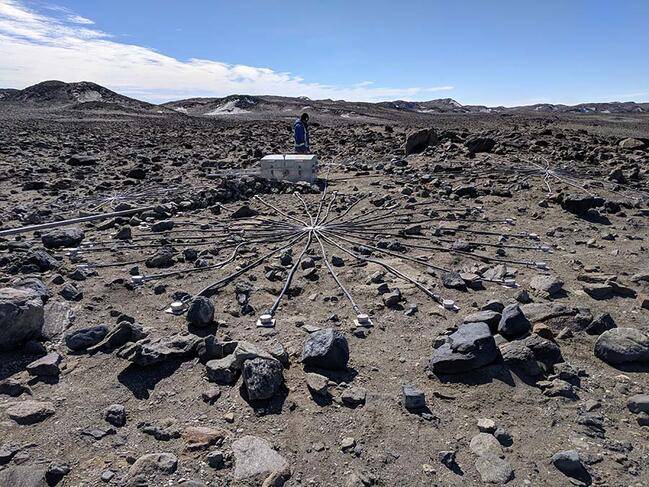From volcanic eruptions to wind turbines, researchers are discovering how extremely low-frequency sound waves travel vast distances and affect human health. New research facilities are helping scientists better understand these mysterious acoustic waves that can circle the planet multiple times.
Original research from CNRS | Estimated reading time: 6 minutes
Article
When Indonesia’s Krakatoa volcano erupted in 1883, its acoustic waves were detected over 10,000 kilometers away in London – not once, but twice. This historic event marked the first recorded measurement of infrasound, mysterious sound waves below 20 hertz that can travel incredible distances.
“It was the first infrasound measurement ever made,” recounts François Coulouvrat, a physicist specialising in acoustics at the Jean le Rond d’Alembert Institute. “In London the wave was actually recorded twice, which means it travelled around the Earth at least two times.”
Unlike high-frequency sounds that quickly dissipate, infrasound waves can propagate over vast distances due to their long wavelengths. These waves emerge from both natural and human sources. As Roberto Sabatini, an academic at the Fluid Mechanics and Acoustics Laboratory in Lyon, explains: “All geophysical phenomena emit infrasound: volcanic eruptions, earthquakes, falling meteorites, tornadoes, lightning, aurora borealis, etc.”
Now, researchers are using new facilities and monitoring networks to understand how these ultra-low frequency sound waves propagate through the atmosphere and potentially impact human health. A team at the Laboratory of Mechanics and Acoustics in Marseille has constructed a specialized infrasound booth to study human perception of these normally “inaudible” sounds.
The research has revealed surprising insights about human hearing. “It is widely accepted that humans hear in the frequency band between 20 Hz and 20,000 Hz, with extreme sensitivity around 100-200 Hz, corresponding to the basic frequency of the human voice, and up through 4,000 Hz,” indicates Sabine Meunier, a specialist on psychoacoustics. “However, these thresholds were established at a time when we knew little about very low frequencies. All of us can actually hear frequencies below 20 Hz at relatively high levels that are not common in everyday life, with our ears being less sensitive to very low frequencies.”
The 40-cubic-meter testing booth, equipped with 72 loudspeakers, can reproduce infrasound up to 100 decibels. This allows researchers to study how people perceive wind turbine noise and other low-frequency sounds. The sensations are unique – at such low frequencies, people don’t hear a continuous tone but rather a regular beating sensation.
The research has important implications as infrasound sources increase worldwide. A global network of 60 monitoring stations now tracks these waves, primarily to detect nuclear tests, but also to study atmospheric conditions and potentially provide early warning of tsunamis.
“The signal we receive at an infrasound station depends on the source and characteristics of the atmosphere,” details Sabatini. “Each source has a particular acoustic signature. So if we know the source, for instance a particular volcanic eruption or earthquake, we can deduce information on the characteristics of the atmosphere, especially the speed and direction of stratospheric winds, which we cannot directly measure, and that are central to improving climate models.”
Perhaps most intriguingly, the research is shedding light on why some people report hearing mysterious low-frequency hums that others cannot detect. “ENT colleagues sometimes contact us on behalf of patients complaining about hearing low-frequency noise in their homes, whose origin they cannot identify, and which nothing seems to stop,” recounts Paul Avan, Director of the Center for Research and Innovation in Human Audiology.
The findings are particularly relevant for communities near wind farms and industrial facilities. Current noise regulations often don’t adequately account for infrasound. “In France, environmental noise is essentially measured in A-weighted decibels (dB A),” points out David Ecotière, the Deputy Director of the Environmental Acoustics joint research unit. “This weighting system can account for the ear’s great sensitivity to certain frequencies by giving them more weight, with a view to assessing the actual discomfort caused by noise such as road traffic, circulating trains, or a concert. However A-weighting is not suitable for frequencies below 125 Hz, for it applies a filter that greatly reduces them.”
As researchers continue to study these mysterious waves, they’re discovering that infrasound is far more complex – and potentially impactful – than previously thought. The ongoing research could lead to better regulations and understanding of how these silent sounds affect our world and our health.
Glossary
- Infrasound
- Sound waves with frequencies below 20 hertz, below the typical threshold of human hearing but detectable at high intensities.
- Psychoacoustics
- The scientific study of sound perception, including how humans experience and interpret sound.
- Acoustic Refraction
- The bending of sound waves as they pass through media of different temperatures or densities in the atmosphere.
- Otoacoustic Emissions
- Sounds produced by the inner ear, used to test hearing function and sensitivity to different frequencies.
Test Your Knowledge
What was the first recorded measurement of infrasound?
The Krakatoa volcanic eruption in 1883, detected by weather stations in London over 10,000 kilometers away.
What is the minimum intensity (in decibels) required for humans to hear a 20 Hz infrasound?
88-90 decibels, equivalent to the noise level in a race car cockpit.
How many infrasound monitoring stations are in the global network that tracks nuclear tests?
60 stations worldwide, with one of the most recent installed in Guadeloupe in 2020.
What atmospheric factor affects infrasound propagation speed and direction?
Both temperature and wind patterns – heating increases sound speed and deflects waves vertically, while cooling decreases speed and shifts waves horizontally.
Enjoy this story? Subscribe to our newsletter at scienceblog.substack.com


